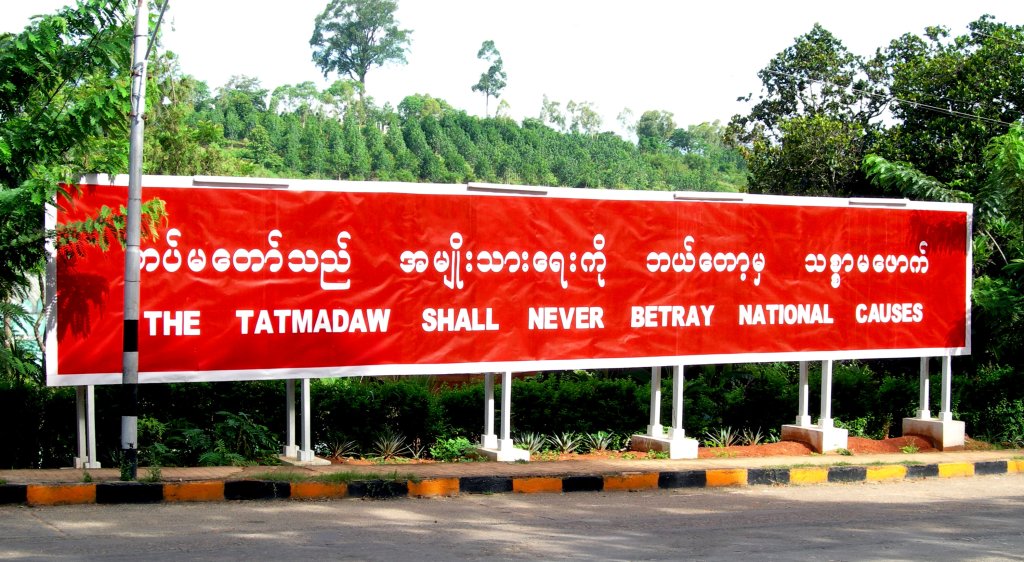Schisms and backtracking in embracing Myanmar
Posted By Sarah Norgrove on January 16, 2013 @ 05:00
 [1]
[1]The world should be thinking twice about lauding Myanmar’s nascent reforms. Recent air strikes directed at Kachin rebels in Shan state by the Myanmar government exacerbate one of the longest-standing civil wars in the country’s post-colonial history. This sharp escalation of force, condemned by the US, the UN and China, gives further credence to suspected schism between the government in Naypyidaw and operational command of the Myanmar Armed Forces (also known as Tatmadaw). There’s also increasing concern that commercial commodity interests will trump prospects for an end to conflict in the region.
With one hand, the junta have made sweeping reforms, invigorating freedom of speech and hopes for democratic rule. There are even liberal sex education publications [2] now hitting Rangoon bookstores. However, the other hand continues to swipe violently at dissidents and rebels, leaving breaches of international law and fickle diplomacy in its wake. This could be explained by the junta’s historically erratic behaviour and its tendency to renege on deals struck with armed wings of its ethnic minorities. It might also illustrate deeper incongruence between the central leadership under President Thein Sein and tactical command amongst the military.
The 17 year-old cease-fire brokered between the Tatmadaw and the Kachin Independence Organisation (KIO) broke down in June 2011 with the brutal crackdown on protesters outside a Chinese mine. Myanmar’s President Thein Sein, despite taking on the war with Kachin rebels as a longstanding challenge, is considered by many as a reformer. He has re-engaged with Aung San Suu Kyi and ASEAN, and has previously expressed reticence in using armed force [3] against civilians. The BBC reported that the President’s office had not been informed of any air attacks [4], but thought planes were being used to re-supply troops.
Burmese Independence Day (4 January) and Kachin State Day (10 January) have traditionally marked a consolidation between the KIO and their armed wing, the Kachin Independence Army (KIA). ANU academic Nicholas Farrelly predicted last year [5] that Thein Sein’s cancellation of a trip to Canberra was largely due to trouble emanating from the town of Laiza, the hub of the Kachin resistance. While there are signs that Thein Sein is responsive to international pressure, this hasn’t translated meaningfully through the ranks of the Tatmadaw, used to deploying brutal methods of repression. Farrelly adopts an optimistic view of Thein Sein’s motives for peace in northern Myanmar, but it seems that the only exchange of views currently taking place between the Tatmadaw and the KIA is through the use of heavy artillery.
Both the US and China would like to have a hand in any deal brokered between the Kachin and the junta. With the US directing more of its diplomatic, political and business enterprise to Asia, its stake in Myanmar’s successful transition to democracy is driven by more than mere ideology. Revenue from gas exports alone is expected to reach $US4.1 billion in 2013. With increasing demand seeing energy corporations squeezing more oil and gas from unconventional sources in Asia, and the concurrent scaling back of traditional fuels like coal, the conflict over land acquisition and use is set to intensify.
Beijing’s diplomatic chagrin [6] regarding the air strikes demonstrates a serious downturn in Myanmar–China relations. A high percentage of the 75,000 people displaced by intensified combat have sought refuge in Chinese border town Ruili. The refugee influx concentrates recent protests from Chinese Kachin [7] to do more to end the war, and the PLA have been deployed to Kachin state [8] to ‘understand the situation’. While a war-torn Myanmar might be a deterrent for deeper engagement with the US, thus aiding Chinese aims of reducing American influence, the consequences of protracted fighting across the border also frustrates China’s strategies to preserve sovereignty, stability and commercial interests.
The renewed violence in Kachin state and the recent crackdown on protestors in the Latpadaung mine [9] reflect the junta’s grave imbalance between protecting the interests of Myanmar’s minorities and its lucrative joint venture mining projects. Australia could be a favourable candidate to engage the Tatmadaw and Myanmar’s armed forces with internationally-acceptable methods of conflict resolution. Its successful military education institutions are already popular among Asia’s defence forces, and unlike the US, Naypyidaw has not cast it a political blackguard. Australian delegates recently met with the Myanmar Chamber of Commerce [10] (AMCC) to promote trade and commerce between the two countries. However, Australia’s new role as overseer of sanctions on the UN Security Council could have mixed implications on future engagement with Myanmar. Australia could now be viewed as a mouthpiece for Western neo-imperialism, or alternatively, a legitimate force with enough political clout to make it worth heeding. Australia could exercise its new role to keep the implications of prematurely easing Myanmar’s sanctions at the forefront of the UNSC’s regional agenda, as well as the impact that protracted conflict will have on commodity-driven markets and joint ventures. War in Myanmar’s north is bad news for all stakeholders, and worse for those caught in the crossfire with no prospective dividend.
Sarah Norgrove is currently undertaking ASPI’s internship program. Image courtesy of Flickr user immu [11].
Article printed from The Strategist: https://www.aspistrategist.org.au
URL to article: https://www.aspistrategist.org.au/schisms-and-backtracking-in-embracing-myanmar/
URLs in this post:
[1] Image: http://www.aspistrategist.org.au/wp-content/uploads/2013/01/101532660_0ecb4bff2b_o.jpeg
[2] liberal sex education publications: http://www.theaustralian.com.au/opinion/world-commentary/hyno-magazine/story-fnfc3mv6-1226549425977
[3] expressed reticence in using armed force: http://asiancorrespondent.com/94882/burma-karen-leaders-urge-president-to-cease-kachin-war/
[4] had not been informed of any air attacks: http://www.bbc.co.uk/news/world-asia-20896639
[5] predicted last year: http://asiapacific.anu.edu.au/newmandala/2012/12/06/next-stop-laiza/
[6] Beijing’s diplomatic chagrin: http://www.defence.pk/forums/china-far-east/228010-myanmar-says-kachin-air-strikes-self-defence.html
[7] recent protests from Chinese Kachin: http://www.irrawaddy.org/archives/23854
[8] the PLA have been deployed to Kachin state: http://www.reuters.com/article/2013/01/11/us-china-myanmar-idUSBRE90A0FN20130111
[9] crackdown on protestors in the Latpadaung mine: http://www.aspistrategist.org.au/adf-tatmadaw-relations-is-myanmar-ready/
[10] Australian delegates recently met with the Myanmar Chamber of Commerce: http://www.myanmar.com/newspaper/nlm/index.html
[11] immu: http://www.flickr.com/photos/immmu/101532660/
Click here to print.